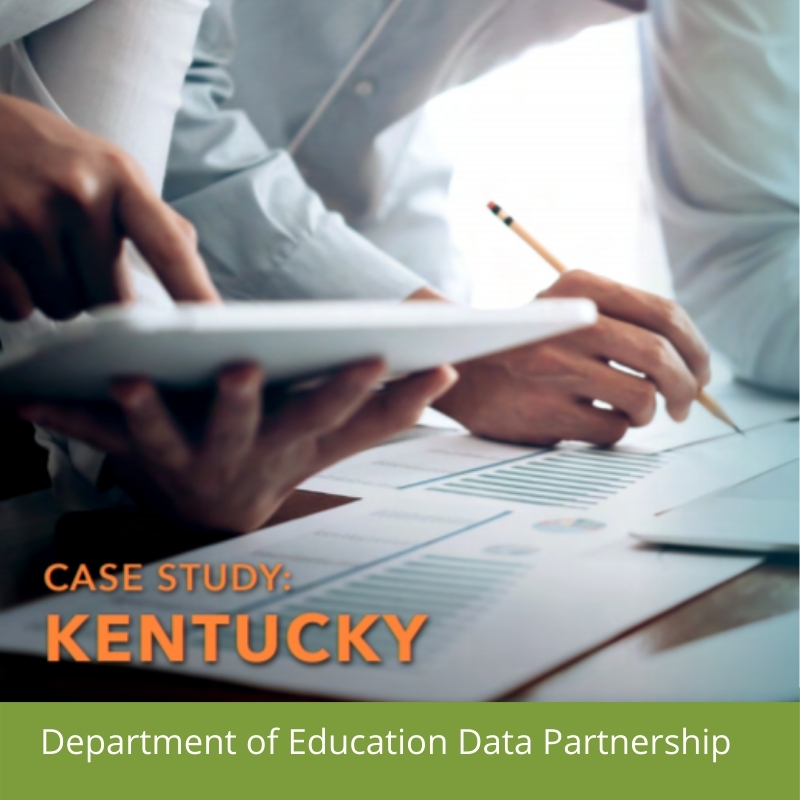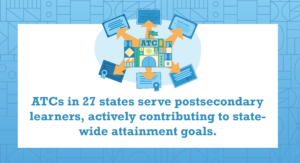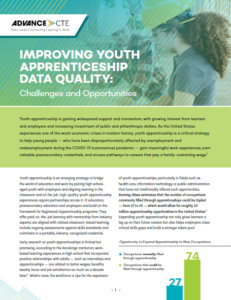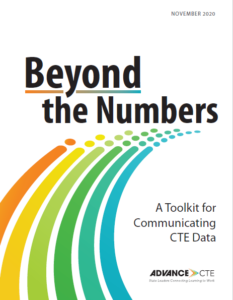The “Getting to Know” blog series will feature the work of State CTE Directors, state and federal policies, innovative programs and new initiatives from the Advance CTE staff. Learn more about each one of these topics and the unique contributions to advancing Career Technical Education (CTE) that Advance CTE’s members work on every day.
 Meet Christina Koch! Christina serves in the role of Policy Associate for Advance CTE. Christina works on projects related to state policy, including the New Skills ready network, initiatives related to Without Limits: A Shared Vision for the Future of Career Technical Education (CTE Without Limits) and supports Advance CTE’s equity initiatives, which currently includes the CTE Learner Voice Shared Solutions Workgroup.
Meet Christina Koch! Christina serves in the role of Policy Associate for Advance CTE. Christina works on projects related to state policy, including the New Skills ready network, initiatives related to Without Limits: A Shared Vision for the Future of Career Technical Education (CTE Without Limits) and supports Advance CTE’s equity initiatives, which currently includes the CTE Learner Voice Shared Solutions Workgroup.
Q: This month, we are sharing resources and best practices for states engaging in Early Postsecondary Opportunities (EPSOs) for learners. How do you define EPSOs?
A: EPSOs include dual enrollment, dual credit, concurrent enrollment and other related opportunities. I would define them as opportunities designed to give each learner a head start on college courses while still in high school to make postsecondary credential and degree attainment easier and more affordable.
Q: How does the shared vision for CTE call for states to create opportunities for each learner to have access to equitable EPSOs?
A: Many aspects of CTE Without Limits focus on removing barriers for learners to reach success in the career of their choice. For example, Principle 2: Each learner feels welcome in, is supported by and has the means to succeed in the career preparation ecosystem, calls for all learners to have equitable access to opportunities so that they can be successful in their career pathways. Increasing equitable access to EPSOs could include making postsecondary credit free to learners and removing grade point average requirements. On the local level, it also means doing targeted outreach to learners from special populations to ensure they are made aware of these opportunities and understand the potential benefits of getting a head start on college courses.
Principle 4 of CTE Without Limits: Each learner’s skills are counted, valued and portable also touches on an important part of ideal ESPOs, in that the credit earned by learners is portable and counted toward their chosen career pathway. It is important that states ensure there are EPSOs available for learners within every career pathway and that credit is easily transferable among public postsecondary institutions.
Q: How are sites that make up the New Skills ready network leading in providing EPSOs?
A: Ensuring that EPSOs are available within every career pathway is definitely a topic of interest among the New Skills ready network sites and some already have really strong initiatives in their states. For example, Nashville, Tennessee is one of the sites in the New Skills ready network and has been expanding their EPSO program for nearly a decade. The state identified EPSOs as one of the most significant ways in which high schools across the state could help prepare learners for postsecondary success and began developing a portfolio of EPSOs. As part of the portfolio approach, all high schools must offer two or more types of EPSOs to ensure that the opportunities are accessible to all high school learners.
Q: Are learners interested in EPSOs? How can states communicate the benefits of EPSOs to increase learner interest?
A: Recent communications research revealed that more than 80 percent of families involved in CTE were satisfied with opportunities to earn college credit and take advanced classes compared to 60 percent or less of families not involved in CTE.
Learners are interested in EPSOs but the challenge is that many do not know that these opportunities are available to them or how to navigate the process of earning postsecondary credit that would be useful to them in their education and career pathway.
New tools and messaging resources are available to help states and local CTE leaders communicate the benefits of EPSOs for secondary learners and recruit families.
Brittany Cannady, Senior Associate Digital Media


 Two hallmarks of a high-quality career pathway are seamless transitions across secondary and postsecondary education and offering learners the opportunity and means to participate in early postsecondary opportunities (EPSOs) – which include dual enrollment, dual credit, concurrent enrollment and other related opportunities. It is critical that these opportunities seamlessly result in articulated postsecondary credit for learners in a degree program that will help them progress on their chosen career pathway with no hidden barriers.
Two hallmarks of a high-quality career pathway are seamless transitions across secondary and postsecondary education and offering learners the opportunity and means to participate in early postsecondary opportunities (EPSOs) – which include dual enrollment, dual credit, concurrent enrollment and other related opportunities. It is critical that these opportunities seamlessly result in articulated postsecondary credit for learners in a degree program that will help them progress on their chosen career pathway with no hidden barriers. A career pathway is a progressive sequence of at least three courses that is aligned to high-skill, high-wage, in-demand occupations; spans secondary and postsecondary; reinforces academic learning with related work-based learning experiences; and embeds opportunities for students to earn both related postsecondary credit in a degree-granting program and industry-recognized credentials.
A career pathway is a progressive sequence of at least three courses that is aligned to high-skill, high-wage, in-demand occupations; spans secondary and postsecondary; reinforces academic learning with related work-based learning experiences; and embeds opportunities for students to earn both related postsecondary credit in a degree-granting program and industry-recognized credentials.  In a high-quality career readiness data ecosystem, states do not report data for data’s sake but rather to foster understanding and to spur users to action. This requires a thoughtful approach to designing and presenting career readiness data and a robust system of professional development, technical assistance and support to ensure practitioners understand how to use the data. Additionally, data elements should be integrated into a state’s communication strategy to tell a career readiness story.
In a high-quality career readiness data ecosystem, states do not report data for data’s sake but rather to foster understanding and to spur users to action. This requires a thoughtful approach to designing and presenting career readiness data and a robust system of professional development, technical assistance and support to ensure practitioners understand how to use the data. Additionally, data elements should be integrated into a state’s communication strategy to tell a career readiness story.  Advance CTE’s recent report on area technical centers (ATCs),
Advance CTE’s recent report on area technical centers (ATCs),  Apprenticeship in the United States is an under-utilized but promising education and employment strategy — particularly for youth whose connections to college and paid work are even more tenuous due to the COVID-19 economic crisis. In 2018, New America launched the Partnership to Advance Youth Apprenticeship (PAYA), a national network of partners (including Advance CTE), states, local intermediaries and philanthropies to define and scale up high-quality youth apprenticeships nationwide. In just a couple short years, the network has made incredible progress, sowing the seeds for future programs.
Apprenticeship in the United States is an under-utilized but promising education and employment strategy — particularly for youth whose connections to college and paid work are even more tenuous due to the COVID-19 economic crisis. In 2018, New America launched the Partnership to Advance Youth Apprenticeship (PAYA), a national network of partners (including Advance CTE), states, local intermediaries and philanthropies to define and scale up high-quality youth apprenticeships nationwide. In just a couple short years, the network has made incredible progress, sowing the seeds for future programs. State leaders can look to best practices in data visualization and accessibility to ensure their CTE reporting tools are widely accessible and equip users to make the most of the data.
State leaders can look to best practices in data visualization and accessibility to ensure their CTE reporting tools are widely accessible and equip users to make the most of the data.  Effective data reporting, however, requires not just well-designed and accessible reports but also a strategy to build understanding among the general public and key stakeholders. What good is data if it isn’t used? Yet state CTE offices are asked to attend to multiple priorities — from program review to professional development to equity monitoring — and communicating CTE data all too often is moved to the backburner.
Effective data reporting, however, requires not just well-designed and accessible reports but also a strategy to build understanding among the general public and key stakeholders. What good is data if it isn’t used? Yet state CTE offices are asked to attend to multiple priorities — from program review to professional development to equity monitoring — and communicating CTE data all too often is moved to the backburner.  Build Your Future is hosting a construction video contest, I BUILT THIS, and giving away more than $20,000 in prizes. Learn more and submit a video
Build Your Future is hosting a construction video contest, I BUILT THIS, and giving away more than $20,000 in prizes. Learn more and submit a video